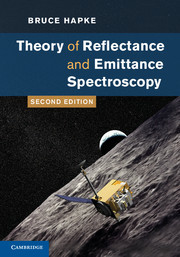Description
Theory of Reflectance and Emittance Spectroscopy (2nd Ed.)
Author: Hapke Bruce
An essential reference for researchers and students of planetary remote sensing on the interaction of electromagnetic radiation with planetary surfaces.
Language: English
Subject for Theory of Reflectance and Emittance Spectroscopy:
Approximative price 104.26 €
In Print (Delivery period: 14 days).
Add to cart
Publication date: 01-2012
528 p. · 18x25.4 cm · Hardback
528 p. · 18x25.4 cm · Hardback
Description
/li>Contents
/li>Biography
/li>
Reflectance and emittance spectroscopy are increasingly important tools in remote sensing and have been employed in most recent planetary spacecraft missions. They are primarily used to measure properties of disordered materials, especially in the interpretation of remote observations of the surfaces of the Earth and other terrestrial planets. This book gives a quantitative treatment of the physics of the interaction of electromagnetic radiation with particulate media, such as powders and soils. Subjects covered include electromagnetic wave propagation, single particle scattering, diffuse reflectance, thermal emittance and polarisation. This new edition has been updated to include a quantitative treatment of the effects of porosity, a detailed discussion of the coherent backscatter opposition effect, a quantitative treatment of simultaneous transport of energy within the medium by conduction and radiation, and lists of relevant databases and software. This is an essential reference for research scientists, engineers and advanced students of planetary remote sensing.
Acknowledgements; 1. Introduction; 2. Electromagnetic wave propagation; 3. The absorption of light; 4. Specular reflection; 5. Single particle scattering: perfect spheres; 6. Single particle scattering: irregular particles; 7. Propagation in a nonuniform medium: the equation of radiative transfer; 8. The bidirectional reflectance of a semi-infinite medium; 9. The opposition effect; 10. A miscellany of bidirectional reflectances and related quantities; 11. Integrated reflectances and planetary photometry; 12. Photometric effects of large scale roughness; 13. Polarization; 14. Reflectance spectroscopy; 15. Thermal emission and emittance spectroscopy; 16. Simultaneous transport of energy by radiation and conduction; Appendix A. A brief review of vector calculus; Appendix B. Functions of a complex variable; Appendix C. The wave equation in spherical coordinates; Appendix D. Fraunhoffer diffraction by a circular hole; Appendix E. Table of symbols; Bibliography; Index.
Bruce Hapke is Professor Emeritus of Geology and Planetary Science at the University of Pittsburgh, where he continues to study various bodies of the solar system. He was principal investigator for the analysis of lunar samples and was associated with several other NASA missions, to Mercury, Mars, Saturn and the outer solar system. He is a Fellow of the American Geophysical Union and was awarded the Kuiper Prize by the Division for Planetary Sciences of the American Astronomical Society for 'outstanding contributions to planetary science'. He has an asteroid 3549 Hapke and a mineral Hapkeite named in his honour.
© 2024 LAVOISIER S.A.S.



